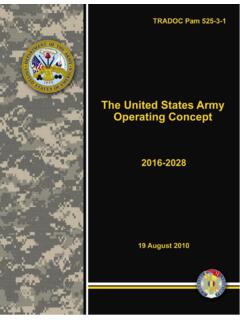Transcription of ATP 6-02.54 TECHNIQUES FOR SATELLITE …
1 ATP TECHNIQUES FOR SATELLITE COMMUNICATIONS JUNE 2017 DISTRIBUTION RESTRICTION: Approved for public release; distribution is unlimited. Headquarters, Department of the Army This publication is available at the Army Publishing Directorate site ( ), and the Central Army Registry site ( )ATP DISTRIBUTION RESTRICTION: Approved for public release; distribution is unlimited. i Army TECHNIQUES Publication No. 6- Headquarters Department of the Army Washington, DC, 5 June 2017 TECHNIQUES for SATELLITE Communications Contents Page v INTRODUCTION .. vii Chapter 1 SATELLITE COMMUNICATIONS 1-1 Fundamentals .. 1-1 Types of SATELLITE Communications .. 1-4 Chapter 2 ROLES AND RESPONSIBILITIES .. 2-1 Joint and Department of Defense.
2 2-1 Department of the Army .. 2-4 Chapter 3 ARMY SATELLITE COMMUNICATIONS ARCHITECTURE .. 3-1 Overview .. 3-1 Requirements .. 3-1 Objectives .. 3-2 Operational Considerations .. 3-3 Chapter 4 SATELLITE COMMUNICATIONS PLANNING .. 4-1 Joint Planning .. 4-1 Army SATELLITE Communications Planning .. 4-3 Narrowband SATELLITE Communications .. 4-9 Wideband SATELLITE Communications .. 4-9 Protected SATELLITE Communications .. 4- 10 Commercial SATELLITE Communications .. 4- 11 Warfighter Information Network-Tactical Equipped SATELLITE Communications Planning .. 4- 15 Chapter 5 SATELLITE COMMUNICATIONS ENABLERS .. 5-1 United States Strategic Command .. 5-1 United States Army Space and Missile Defense Command/Army Forces Strategic Command .. 5-1 United States Army Network Enterprise Technology Command .. 5-2 Distribution of Signal Units.
3 5-3 Appendix A THE TERMINAL SEGMENT .. A-1 Appendix B GLOBAL POSITIONING SYSTEM .. B-1 Appendix C DEMAND ASSIGNED MULTIPLE ACCESS AND INTEGRATED WAVEFORM .. C-1 GLOSSARY .. Glossary-1 REFERENCES .. References-1 ATP Contents ii ATP 5 June 2017 INDEX .. Index-1 Figures Figure 1-1. Wideband global SATELLITE communications coverage areas .. 1-5 Figure 1-2. Regional SATELLITE communications support center coverage .. 1-6 Figure 1-3. Global Broadcast Service broadcast route .. 1-8 Figure 1-4. Global Broadcast Service operations overview .. 1-9 Figure 1-5. Milstar vs advanced extremely high frequency bandwidth .. 1- 14 Figure 1-6. MUOS and ultrahigh frequency follow-on SATELLITE constellation .. 1- 16 Figure 4-1. Joint SATELLITE communications operations management .. 4-2 Figure A-1. Department of Defense gateway locations.
4 A-2 Figure A-2. Teleport A-3 Figure A-3. AN/FSC-78 terminal .. A-5 Figure A-4. AN/GSC-39(V1) terminal .. A-6 Figure A-5. AN/GSC-52(V) terminal .. A-7 Figure A-6. Family of modernization enterprise terminals .. A-8 Figure A-7. AN/TSC-86A terminal .. A-9 Figure A-8. AN/TSC-93E Lynx terminal .. A- 10 Figure A-9. AN/TSC-156 Phoenix terminal .. A- 11 Figure A-10. Secure Mobile Anti-Jam Reliable Tactical Terminal .. A- 12 Figure A-11. Global Broadcast Service tactical receive suite .. A- 13 Figure A-12. Global Broadcast Service portable receive suite .. A- 14 Figure A-13. AN/USC-60 flyaway tri-band SATELLITE terminal .. A- 15 Figure A-14. SIPRNET/NIPRNET Access Point .. A- 16 Figure A-15. Tactical communications A- 20 Figure A-16. SATELLITE transportable terminal .. A- 21 Figure A-17. Point of Presence .. A- 22 Figure A-18.
5 Soldier network extension .. A- 22 Figure B-1. How the global positioning system works .. B-4 Figure C-1. Information throughput without demand assigned multiple access .. C-2 Figure C-2. Demand assigned multiple access capable terminals .. C-3 Figure C-3. Comparison of a 25 kbps demand assigned multiple access vs. integrated waveform frame .. C-5 Contents 5 June 2017 ATP iii Tables Table 1-1. Radio frequency bands .. 1-2 Table 4-1. SATELLITE communications priorities .. 4-6 Table A-1. Mobile Warfighter Information Network-Tactical SATELLITE communications capabilities . A-19 This page intentionally left blank. 5 June 2017 ATP v Preface ATP provides TECHNIQUES for the Army SATELLITE communications (SATCOM) community. The intent of this publication is to educate communicators on the multitude of options that are available utilizing SATCOM.
6 This publication includes information for planning, establishing, and operating communications networks utilizing satellites. The principal audience for ATP is Army professionals and contractors whose duties involve designing, building, configuring, securing, operating, maintaining, and sustaining the SATCOM systems. This publication provides SATCOM information and guidance to commanders, staffs, operators, and maintainers that execute SATCOM for the Army. ATP is a significant resource to Army SATCOM trainers and educators. Commanders, staffs, and subordinates ensure their decisions and actions comply with applicable , international, and, in certain cases, host-nation laws and regulations. Commanders at all levels ensure their Soldiers operate according to the law of war and the rules of engagement (see FM 27-10).
7 ATP uses joint terms where applicable. Selected joint and Army terms and definitions appear in both the glossary and the text. For definitions shown in the text, the term is italicized and the number of the proponent publication follows the definition. This publication is not the proponent for any Army terms. For other definitions shown in the text, the term is italicized and the number of the proponent publication follows the definition. ATP applies to the Active Army, Army National Guard/Army National Guard of the United States, and Army Reserve unless otherwise stated. The proponent of ATP 6- is the Army Cyber Center of Excellence. The preparing agency is the Cyber Center of Excellence Doctrine Division, Army Cyber Center of Excellence. Send comments and recommendations on a DA Form 2028 (Recommended Changes to Publications and Blank Forms) to Commander, Army Cyber Center of Excellence, ATTN: ATZH-ID (ATP ), 506 Chamberlain Avenue, Fort Gordon, GA 30905-5735; by electronic mail to This page intentionally left blank.
8 5 June 2017 ATP vii Introduction ATP , TECHNIQUES for SATELLITE Communications, identifies and explains the role of SATCOM as a part of the Army s transport layer for connection to Defense Information Systems Network (DISN) services. ATP expands on the doctrinal foundations and tenets found in FM 6-02, Signal Support to Operations. The vision for the Department of Defense Information Network-Army (DODIN-A) is the employment of an end-to-end network that provides assured global mission command and enables the Army to fight and win in a contested and congested operating environment. This network seamlessly integrates services and capabilities from strategic to tactical echelons and enables all warfighting functions. The network is a warfighting platform that enables the mission command system to integrate joint combined arms and all elements of combat power; support leaders ability to understand, visualize, and describe the operational environment, problems, and approaches to solving them; support commanders ability to make decisions and direct action toward a desired end state; assess understanding of the problem and adequacy of the operational approach and subsequent plans and level of progress.
9 The network is tailorable and will adapt based on phases of the operation to provide assured mission command in home station, en route, and in deployed environments. Deployed environments include training, exercises, security cooperation engagement, initial entry, and combined arms maneuver, which may employ minimal to robust force packages requiring the network to adjust to provide appropriate services at the point of need under all conditions. We will seek to provide services at point of need and, through home station mission command, reduce the deployed footprint and operational risk. The ability to predict the actions of enemies and adversaries enables proactive defense and assures access to critical data and the security of our networks and systems, which is essential to our mission success. The network must embrace common standards from a joint and multi-national perspective that allow the addition of capabilities and systems while reducing, not increasing complexity of the network.
10 The network must provide an advantage and not a burden while providing enhanced speed and agility to our warfighting formations. The SATCOM network capabilities provided by Signal Soldiers play a vital role in supporting Army operations by providing an information advantage. Today s Army demands the reliable network transport provided by SATCOM to receive information for situational understanding necessary to conduct Army operations. Network transport and information services is a core competency of the Signal Corps. Planners integrate SATELLITE assets to support the commander and the operational mission plan. SATCOM capabilities are vital to increasing the Army s combat power and that of its joint, interorganizational, and multinational partners. As the evolution of capabilities make our networks less complex and more defensible, we will evolve our doctrine to describe the current and effective employment of our networks and systems in a congested and contested operating environment.















